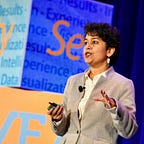Data Literacy 101
Joel is the newly-appointed CEO of a 100-year-old consumer company. He has been brought in with a vision to make the company customer-centric and tasked with leading digital transformations so that it is at par with the new information era.
After taking the reins of the company, he spends his first six weeks getting the lay of the land, understanding its culture, products, and customers. Following his assessment, he develops a strategic plan to present before the board.
In his presentation, Joel points out four areas that need attention. One of these key focus areas is making the entire organization Data Literate. He believes developing Data Literacy across the organization would ultimately support the remaining three — customer-first attitude, innovation, and employee engagement. The board is sold over his presentation, and the newly-appointed CEO gets the buy-in.
To execute the plans of developing Data Literacy for his organization, Joel continues to focus on the power of data and decision-making. He decides to partner with us on the basis of our seven years of leading-edge expertise in building internal organizational capability on data and analytics.
We develop a year-long partnership of infusing data in the DNA of the organization.
Just like us, Joel recognizes that:
· Data literacy doesn’t happen overnight.
· Changing the culture of the organization needs executive buy-in, assessment, strategic planning, seamless execution, and measurement.
He gives us the runway and we make it happen. After our work is done, Joel stands true to his appointment as the CEO, and the company can now boast of being Data Literate.
I would like to share with you our key learnings from Joel’s mission and others we have been involved in that may prove helpful if you wish to bring Data Literacy into your organization.
Before we delve deep into various facets of Data Literacy, let us understand what it means. Data Literacy is the ability to read, digest, and interpret data towards meaningful discussions and conclusions. However, Data Literacy does not work alone — it is supported by three other pillars of Analytics Maturity. Without them, being Data Literate would not bear preferred results. Here are the four components of Analytics Maturity.
1. Data-driven leadership — The leaders of the organization understand the power of data as well as analytics and have a strong motivation to lead by numbers.
2. Data Literacy across the organization — Both the analytics and the non-analytics side of the organization have an appropriate level of Data Literacy.
3. Decision-making process — There exists a mechanism to make decisions in the organization, which is aligned with the key drivers of the business. This helps in understanding how work moves the key metrics, thereby adding value to the company.
4. Data Maturity — There is a single source of truth for data, i.e. people can access data with ease and that data is accurate.
Decisions are being made in every corner of the organization. These small decisions cumulatively make a big difference. When each and every individual decision maker of your organization can marry intuition with data, i.e they are data literate, then business decisions are fully optimized and grounded in reality and will eventually result in amazing products being built that your end users love.
Do you want our entire game plan on how to do it? Download our FREE Data Literacy whitepaper here. As always, comments, shares, and likes are welcome.
